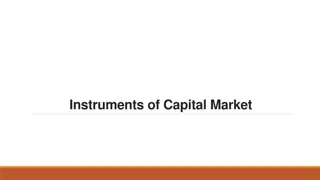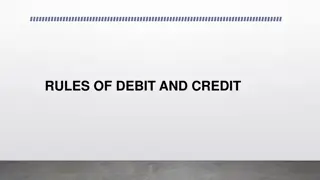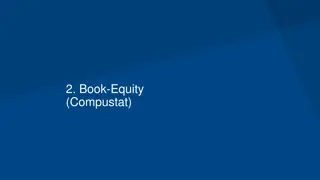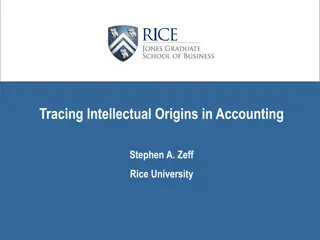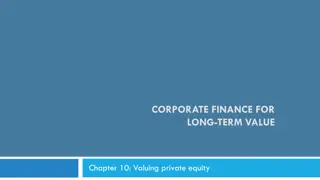Understanding Buy-Back of Equity Shares in Financial Accounting
This content discusses the key concepts related to buy-back of equity shares in financial accounting. It covers topics such as preparation of final accounts of companies, internal reconstruction, investment accounting, ethical behavior for accountants, conditions of buy-back, free reserves, and how to calculate offer price and number of shares. It explains the requirements, regulations, and calculations involved in the buy-back process, providing a comprehensive overview for students and professionals in the field of financial accounting.
Download Presentation

Please find below an Image/Link to download the presentation.
The content on the website is provided AS IS for your information and personal use only. It may not be sold, licensed, or shared on other websites without obtaining consent from the author. Download presentation by click this link. If you encounter any issues during the download, it is possible that the publisher has removed the file from their server.
E N D
Presentation Transcript
CLASS : T.Y.B.COM SUBJECT : FINANCIAL ACCOUNTING SEM: V 1. 1. Preparation of Final Accounts of Companies Preparation of Final Accounts of Companies 2. 2. Internal Reconstruction Internal Reconstruction 3. 3. Buy Back of Shares Buy Back of Shares 4. 4. Investment Accounting Investment Accounting 5. 5. Ethical Ethical Behaviour Behaviour and Implications for Accountants and Implications for Accountants
TOPIC TOPIC Buy Back of Equity Shares Buy Back of Equity Shares S.68 of Companies Act deals with Buyback of Shares by company. This section corresponds to section 77A (Power of company to purchase its own securities) of the 1956 Act. The company whether it is public or private, to purchase its own shares or other specified securities out of following sources according to section 68(1) of the Companies Act, 2013:- b) The securities premium account; or c) The issue of any shares or other specified securities. a) Its free reserves; or
CONDITIONS OF BUY BACK CONDITIONS OF BUY BACK a) Company s article should permit the buy-back ; b) A special resolution or board resolution has been passed at a general meeting of the company authorizing the buy-back. c) The buyback is 25% or less of the aggregate of paid-up capital and free reserves of the company. d) Debt Equity Ratio should not exceed 2:1 after buy-back. e) Only fully paid shares are bought back. f) Every buy-back should be completed within 1 year from the date of passing of the special resolution or the board resolution.
Free Reserves Free Reserves Non Free Reserves Non Free Reserves Meaning Free reserves are those reserve which can be utilised for any purpose. It is also called as divisible profit. Purpose To declare dividend, bonus, remove losses. Non free reserves are created for specific purpose. It is also called as non-divisible profit. To write off specific losses Examples P&L, General Reserve, Revenue Reserve, Reserve Fund, Dividend Equalisation Reserve, **Investment Allowance Reserve (Unutilised) Capital Reserve, CRR, Security Premium, DRR, Statutory Reserve, Forfeited Shares A/c.
HOW TO CALCULATE OFFER PRICE & NO.OF SHARES? STEPS: 1. 1. 2. 2. Sources of buy back = Free reserves + Security premium Sources of buy back = Free reserves + Security premium 25% of owned fund = (Share capital + Free reserves + Security 25% of owned fund = (Share capital + Free reserves + Security premium) X 25% premium) X 25% Owned fund after buy back = Owned fund Owned fund after buy back = Owned fund Borrowed fund Max. Max. no.of no.of equity shares = equity shares = Equity share capital X 25% Equity share capital X 25% Face value 3. 3. 4. 4. Borrowed fund Face value
1 1- - IF OFFER IF OFFER PRICE PRICE IS NOT GIVEN: IS NOT GIVEN: 1. 1. 2. 2. 3. 3. 4. 4. Sources of buy back = Free reserves + Security premium Sources of buy back = Free reserves + Security premium 25% of owned fund = (Share capital + Free reserves + Security premium) X25% 25% of owned fund = (Share capital + Free reserves + Security premium) X25% Owned fund after buy back = Owned fund Owned fund after buy back = Owned fund Borrowed fund Max. Max. no.of no.of equity shares = equity shares = Equity share capital X 25% Equity share capital X 25% Face value Face value Borrowed fund Offer Price = Offer Price = Least of 1/2/3 Max.shares Least of 1/2/3 Max.shares
2 2- - IF OFFER PRICE IS GIVEN: IF OFFER PRICE IS GIVEN: 1. 1. 2. 2. 3. 3. 4. 4. Face value = Max shares X Offer price = Max shares X Offer price Sources of buy back = Free reserves + Security premium Sources of buy back = Free reserves + Security premium 25% of owned fund = (Share capital + Free reserves + Security premium) X25% 25% of owned fund = (Share capital + Free reserves + Security premium) X25% Owned fund after buy back = Owned fund Owned fund after buy back = Owned fund Borrowed fund Max. Max. no.of no.of equity shares = equity shares = Equity share capital X 25% Equity share capital X 25% Face value Borrowed fund Maximum Shares = Maximum Shares = Least of 1/2/3/4 Offer Price Least of 1/2/3/4 Offer Price






